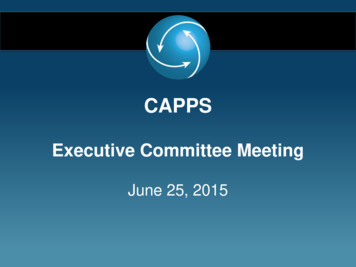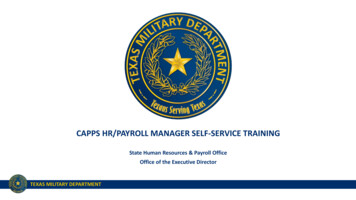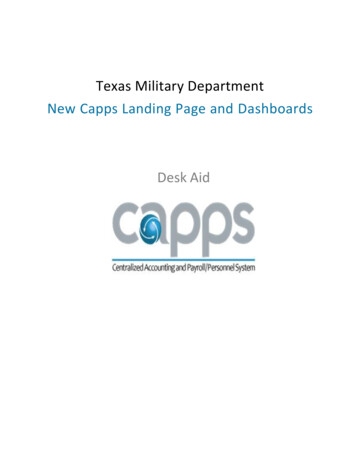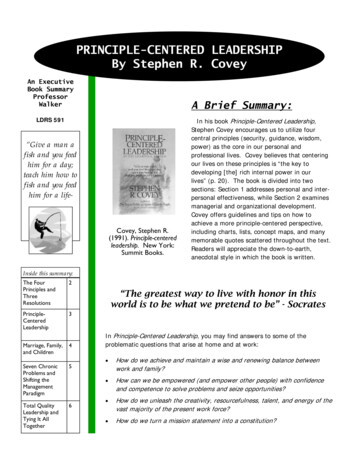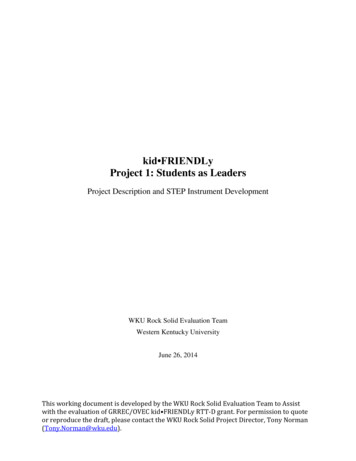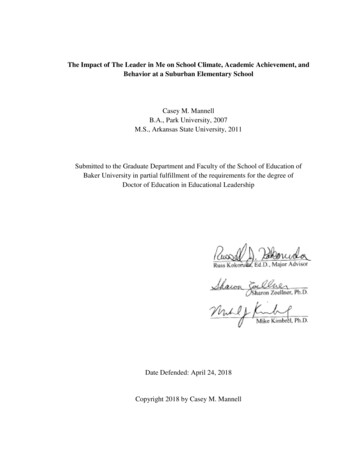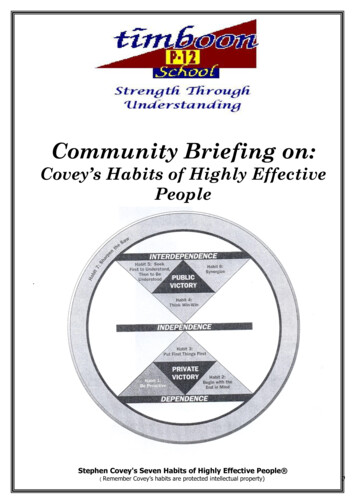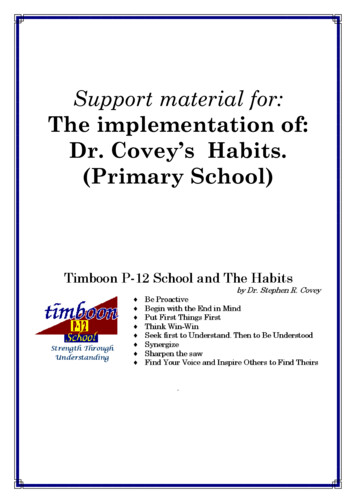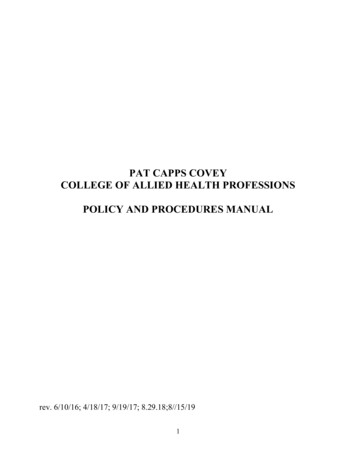
Transcription
PAT CAPPS COVEYCOLLEGE OF ALLIED HEALTH PROFESSIONSPOLICY AND PROCEDURES MANUALrev. 6/10/16; 4/18/17; 9/19/17; 8.29.18;8//15/191
Table of Contents1. General Information . 31.1Introduction. 31.2History . 31.3Mission Statement of the Pat Capps Covey College of Allied Health Professions . 31.4Administrative Organization . 31.5College of Allied Health Standing Committees . 42. Faculty . 62.1Faculty Appointments: Tenure-track and non-tenure-track, and Instructor Appts. 62.2Non-Faculty Appointments: Skills Lab Assistants and Teaching Assistants . 72.3Annual Faculty Evaluation . 8College of Allied Health Professions . 102.4Guidelines and Procedures Pertaining to Promotion and Tenure . 102.5Annual Reports of Scholarly Activities . 182.6Awards for Teaching, Service and Research . 182.7New Courses/Curriculum Action Forms (CAF) . 182.8Research Compliance . 193. Academic Programs and Students’ Affairs . 213.1Degrees Offered . 213.2Admission Reports . 213.3Background Checks for Previous Felony Convictions . 223.4Drug Testing Policy and Procedures . 233.5Biosafety . 263.6Immunizations . 273.7Standard Precautions . 303.8Reporting Exposure . 303.9Post-Exposure Prophylaxis (PEP) Program. 304. Office of Academic Advising. 314.1Advising. 314.2Recruitment. 314.3Other responsibilities . 32Appendices . 33Appendix 1: Annual Faculty Evaluation Forms . 34Appendix 2: Tenure and Promotion Information . 44Appendix 3: Information to be Included in the Annual Report of Scholarly Activities . 502
Pat Capps Covey College of Allied Health ProfessionsPolicy and Procedures Manual1. General Information1.1IntroductionThis Administrative Manual includes a list of procedures and regulations that are specificto the Pat Capps Covey College of Allied Health Professions. For a complete listing of rules andregulations for faculty, staff and students affiliated with the University of South Alabama thereader should refer to the Faculty Handbook, Staff Handbook and the Lowdown, available d airs/lowdown/1.2HistoryThe University of South Alabama was created by Act of the Alabama State Legislature andapproved May 9, 1963. All provisions relating to the establishment and operation of the Universityof South Alabama embodied in the Act are found in Sections 16-55-1 through 16-55-9, Code ofAlabama 1975. The Pat Capps Covey College of Allied Health Professions was established inAugust of 1975 and continued to grow through the years with the addition of academic programs.1.3Mission Statement of the Pat Capps Covey College of Allied HealthProfessionsThe Pat Capps Covey College of Allied Health Professions is dedicated to the provision ofthe highest quality education in the basic medical sciences, the applied sciences, and professionalhealth programs as well as to the creation and dissemination of new knowledge through research inorder to address the health care needs of the Gulf Coast region and the country.1.4Administrative OrganizationDeanThe Dean is the executive officer of the college and reports directly to the Provost andSenior Vice President for Academic Affairs and indirectly to the President of the institution. TheDean also has a seat on the Academic Affairs Dean’s Council. Responsibilities of the Dean aredescribed in section 2.7 of the Faculty Handbook.Associate DeanThe Associate Dean reports to the Dean and has the following responsibilities: all matters related to curriculum3
registration activitiesevaluation of student transfer recordsall matters pertaining to student program admissions, records, credit by examination,advanced credit, and student advisingsupervision, and administration of college graduate programsstudent recruitment and retentionother duties as assigned by the DeanDepartment ChairsThe Department Chairs report to the Dean and serve as senior administrative and academicofficers for their departments. Responsibilities of the Department Chair are described in section2.8.1 of the Faculty Handbook.1.5College of Allied Health Standing CommitteesChairs’ CouncilThe Chairs Council serves as an advisory body to the Dean of the College to evaluate andrecommend changes in policy and procedures. Members of this committee include all Chairs, theAssociate Dean, and it is chaired by the Dean or designee. Meetings are held on a regularlyscheduled basis or as needed.External Advisory BoardThe goal of this Board is to assist the College in improving the quality of education, ourresearch and scholarship, and our service to the community. The committee members of theExternal Advisory Board are successful members of the community who work in the health arenawho may or may not be alumnae. They provide guidance into the future health care needs of ourregion and the country and provide advice and council on the academic programs offered by theCollege. Members are appointed by and serve at the pleasure of the Dean.College Academic Standards CommitteesThe College appoints two committees for academic standards, one for graduate studentsand the other for undergraduates. The committee only meets should a student be accused ofviolations of Academic policies (see The Lowdown ffairs/lowdown/ ).Faculty Evaluation, Promotion and Tenure CommitteeThis committee is appointed every year to review faculty portfolios for tenure and/orpromotion. For more information, see section on Promotion and Tenure.Curriculum/Academic Programs CommitteeThe purpose of the Curriculum/Academic Programs Committee is to assist the College andits Departments in assessing the proposal and implementation of new and/or revised curricula or4
Programs initiated within the College. The committee will review all new and/or revised courseproposals (curriculum action forms), proposed substantive changes in current programs of study,and new degree program proposals within the College and recommend approval or disapproval ofsame to the Dean. Specific areas of assessment include but are not limited to: review of all newcourse proposals for overlapping and duplication within the College; review of new programproposals for relevance to the mission of the Department and College, demonstrated regional andnational societal need, resource implications, adequacy of Departmental resources to deliver theprogram and/or recommendations concerning academic affairs as deemed appropriate.The committee shall submit a report to the Dean or designee indicating theirrecommendation(s) for approval, disapproval, or amendment of the proposed action. Integral tothe committee's operation is the acquisition of adequate input from the department program inorder to study the proposal, assess academic relevance, reflect on specific action proposal andformulate a recommendation on the action proposed to the Dean. The Committee has the right torequest additional or clarifying information to facilitate its review.College Biosafety CommitteeThe Biosafety Committee provides oversight to insure compliance with all applicablefederal, state, and local biohazard requirements (see below). The committee is chaired by theBiosafety Officer of the Pat Capps Covey College of Allied Health Professions.5
2. Faculty2.1Faculty Appointments: Tenure-track and non-tenure-track, andInstructor AppointmentsFaculty holding terminal degrees in their discipline may be appointed to tenured, tenuretrack, non-tenure track, full-time, and/or part-time appointments at the time of their employment inthe university. Designation of faculty appointments shall be specified at the time of employment inthe offer of employment letter from the President. Faculty appointment eligibility and rankdesignation are described in section 3.8 and 3.10.2 of the Faculty Handbook. Faculty appointed toTenure Track appointments will be subject to the same promotion and tenure policies as specifiedin Sections 3.10 and 3.11 of the Faculty Handbook. Traditional ranks of tenure-track faculty areAssistant Professor, Associate Professor, and Professor.Non-tenure track appointments are typically made for positions with specific workloadassignments that are primarily devoted to clinical, teaching, research or administrative functionsand not of sufficient breadth to facilitate required activities/progress in a tenure track position.Non-tenure track appointments are also made for positions supported by extramural funding. SeeSection 3.14 of the Faculty Handbook. Depending upon credentials and qualifications, a facultymember who earned a terminal degree in their field (or related field) could be appointed asAssistant Professor, Associate Professor, or Professor. For those individuals without a terminaldegree in their field (or related field), the rank of Instructor or Senior Instructor are available. Theterminal degree is determined by the Department faculty based on guidance from each discipline’saccrediting body as well as CHEA and SACS.Non-Tenure Track PositionsDesignation of an approved non-tenure track faculty position requires written justificationby the Dean and must be approved by the Provost and Senior Vice President for Academic Affairs.Non-tenure track faculty positions may be approved in any of the following instances: when the position satisfies a current need but may not be needed in the futurewhen a program requires positions to satisfy a current need but the program may not beneeded in the futurewhen the position is funded with grants and/or other temporary funding sourceswhen the duties of the position exclude either teaching or research as a major responsibilitywhen the position does not require a terminal degreeChange of Appointment Status for Non-Tenure Track FacultyProcedures and conditions governing change from non-tenure track faculty appointmentstatus to tenure track faculty appointment status are as follows: Persons holding non-tenure trackappointments will not be eligible for consideration for tenure track faculty rank, except assuccessful applicants responding to a normal, advertised search along with other candidates underaffirmative action procedures. Change from non-tenure track status to tenure track status is notautomatic. Appointment to a tenure track position will be treated as a new appointment and theappointee must submit in writing his/her resignation from the non-tenure track appointment.Origination of recommendation and procedures relative to the change in appointment will followprocedures identical to those for appointment of new faculty.6
Promotion Following Completion of Terminal DegreeFaculty members who are appointed as Instructors may be considered for promotion uponcompletion of the terminal degree if the following conditions are met: Approval received from the Chair and the Dean to pursue the degree for the purposes ofpromotion, merit, and retention.Receipt of official transcripts sent to department chair directly from the awardinginstitution.Verification of degree by the Office of the Provost and Senior Vice President for AcademicAffairs (Note: USA Faculty Consent Form must be completed by faculty member).Recommendation forwarded by the Department Chair through normal administrativechannels for approval by the Dean and Provost.Final promotion decisions are made by the President, subject to approval by the Board ofTrustees.Clinical Adjunct Professor of (Department Name)This is an honorary designation for external clinical supervisors/preceptors who overseestudents placed in their clinics for their external clinical rotations.2.2Non-Faculty Appointments: Skills Lab Assistants and TeachingAssistantsProfessionals who have specialized certification or qualifications may be appointed as aSkills Lab Assistant or as a Teaching Assistant. The Skills Lab Assistant will work with theinstructor of record to plan and administer laboratory activities in the skills lab setting. The SkillsLab Assistant will provide instruction and oversight of students in the skills lab setting but will notdesign the lab or course, develop or conduct student assessment, or serve as the instructor ofrecord. The Teaching Assistant will have the primary responsibilities of teaching and preparinglaboratories under the supervision of the instructor of record.7
2.3Annual Faculty EvaluationThe Pat Capps Covey College of Allied Health Professions shares the mission of theUniversity of South Alabama to provide educational programs and experiences of high quality, toengage in scholarly activities that contribute to professional, academic and educational knowledge,and to engage in services and activities that support the University and the community. Facultymembers have an obligation to participate in and make contributions to each of these activities, butnot every individual will contribute in the same proportion to each of these areas. Any deviationfrom the normally prescribed workload allocation must be approved in advance by the Chair andthe Dean. A major goal of faculty development and evaluation is to recognize the unique talentsand accomplishments of each faculty member while meeting the objectives and needs of theinstitution.Each faculty member is responsible for establishing and achieving academic objectives.These objectives should be discussed with the Chair of the department so that institutional needscan be met and resources effectively allocated. Guidelines must be consistent with the UniversityAffirmative Action Plan and they are subject to approval by the Dean. Goals and objectives maychange over the course of the evaluation period. In this case, an amended Faculty ObjectivesReport may be discussed and agreed upon by the faculty member and Chair.No later than May 31, the faculty member reports to the Chair on his/her accomplishmentsfor the preceding year (June 1 to May 31). The Faculty Report includes: Annual Faculty Activities ReportAny other supporting documentsFaculty Objectives for the upcoming academic yearA copy of the Faculty Objectives form for the year under evaluation todetermine the degree of completion of previous objectivesBrief Description of Forms (see forms in Appendix 1)1. Annual Faculty Activities ReportThe Faculty Activities Report summarizes all the accomplishments for the year underevaluation and includes publications, presentations, grants, and other scholarly and serviceactivities that are additional to those on the list of objectives. Supporting documentation(teaching dossiers, copies of publications, etc.) may be included as needed.2. Faculty Objectives FormOn this form the faculty member and the Chair set the objectives for the following year. Thegoals and objectives for the following year are mutually agreed upon by the faculty memberand the Chair. The Department Chair, in consultation with the Dean, selects methods ofevaluation and score determination for each activity. The form lists each of the itemssummarized in the Affirmative Action Plan Evaluation.8
3. Affirmative Action Plan Evaluation (AAP)Complete identification portion at top of the form and indicate faculty status by checking theright hand column. Allocation of weights is established at the beginning of the evaluation yearas recorded on the signed AAP and Faculty Objectives forms. Scores are derived byevaluating the information submitted by the faculty. Each faculty member's productivity iscompared with objectives submitted at the beginning of the academic year.WeightsWeights for the Faculty Objectives and the Affirmative Action (AAP) forms refer to thepercentage of time and/or percentage of effort devoted to a particular activity. Percentages oftime/effort across all activities on the Faculty Objectives form must total 100 percent.Percentage of time spent or effort is converted to weights of 10.0 for calculations on theAffirmative Action form. For example, 60% time/effort for teaching is converted to a weight of6.0 on the AAP form. The typical allocation of time for tenured/tenure-track faculty is: 60% oftime devoted to teaching, 30% of time devoted to scholarly activities, and 10% of time devoted toservice. The typical allocation for non-tenure track faculty is 90% of time devoted to teaching and10% of time devoted to service.Evaluation ScoresEvaluation Scores on both the Faculty Objectives and Affirmative Action forms shouldreflect the quality, rigor, and professional recognition of the work in the context of contribution tothe mission of the Department, College and/or University. A range of 0 to 10 points is possible foreach activity, with 10 being excellent performance and 0 inadequate.Student rating of teaching performance is mandatory for every course taught and will beminimally completed using the University electronic assessment entitled "Student Evaluation ofTeaching” and will be used as part of the evaluation of teaching performance.Each department in the College shall develop evaluation criteria for each of the areas ofassignment (teaching, service, research, administration). These criteria shall be consistent withcurrent university policies in this regard and must include student evaluations for every coursetaught.Description of the Annual Evaluation Process:No later than June 15th, the Department Chair meets with the faculty member to discuss thereport and to evaluate the degree of completion of objectives listed for the year under evaluationand other accomplishments. The Dean serves as the evaluator for Department Chairs. Decisionsregarding merit pay increase, retention, promotion and tenure will incorporate information fromthese evaluations. The Annual Evaluation involves the following steps:1. During the evaluation the Department Chair (or the Dean if the person being evaluated is achair) meets with the individual faculty member to establish realistic priorities and objectivesfor the coming academic year and to evaluate the accomplishments during the previous year.For new faculty, the Chair should arrange a meeting to establish the Faculty Objectives plan assoon as possible. The areas to be evaluated include:9
a. Teaching assignments are made based on departmental needs and expertise of theinstructor and are assigned by the Chair. The percent of time allocated to instruction forthe year should be based on the average number of credit and/or contact hours (asappropriate for each course) and related responsibilities for each semester; and recorded onthe Faculty Objectives form.b. Scholarly activity objectives should be proposed by the faculty member based onacceptable guidelines established by the departmental faculty approved by the DepartmentChair and the Dean. The Department Chair will review these activities for appropriatenessand with respect to resources and space and time commitments of other departmentalactivities. The objectives are listed and an allocation of time for scholarly activities isrecorded on the Faculty Objectives form.c. Committee assignments and service engagement activities. The faculty member shouldalso list professional and community engagement activities for the coming year that areacademic related. An allocation of time for service activities is entered on the FacultyObjectives form.2. The completed Faculty Objectives form for the upcoming academic year is signed and datedby the faculty member and the evaluator. The University Affirmative Action (AAP) form iscompleted using the percent allocations shown on the Faculty Objectives form. The originalsof both forms are retained by the Department Chair. Copies of all documents are provided tothe faculty member and are also forwarded to the Departmental office and the Dean’s office byJune 15th.3. Progress toward meeting objectives can be reviewed at any time during the academic year, atthe request of the faculty member, the Department Chair, or the Dean. Alteration ofobjectives, reallocation of activities, or changes in assignments should be entered on asupplemental Faculty Objectives form, signed by the faculty member and evaluator, andattached to the original Faculty Objectives form. Copies are distributed as before.4. No later than June 15th, the activities proposed for the upcoming year are listed in a newFaculty Objectives form. After reviewing the report, the Department Chair meets with thefaculty member to formally evaluate the faculty member. The actual assignment of scores foreach activity should be done during or after discussion with the faculty member. The facultymember must have the opportunity to review the evaluation form before it is submitted to thenext administrative level. In cases of disagreement with the faculty objectives and evaluationprocess, faculty may appeal to the Dean and subsequently with the Provost.2.4College of Allied Health ProfessionsGuidelines and Procedures Pertaining to Promotion and TenureFaculty appointed to Tenure Track appointments will be subject to the same promotion and tenurepolicies as specified in Sections 3.10 and 3.11 of the Faculty Handbook. Traditional ranks oftenure-track faculty are Assistant Professor, Associate Professor, and Professor.Non-tenure track appointments are typically made for positions with specific work loadassignments that are primarily devoted to clinical, teaching, research or administrative functionsand not of sufficient breadth to facilitate required activities/progress in a tenure track position.Non-tenure track appointments are also made for positions supported by extramural funding. SeeSection 3.14 of the Faculty Handbook. Depending upon credentials and qualifications, a faculty10
member who earned a terminal degree in their field (or related field) could be appointed asAssistant Professor, Associate Professor, or Professor. For those individuals without a terminaldegree in their field (or related field), the rank of Instructor or Senior Instructor are available. Theterminal degree is determined by the Department faculty based on guidance from each discipline’saccrediting body as well as CHEA and SACS.Candidates for promotion to Professor and those seeking tenure and promotion to AssociateProfessor will be required to follow the processes and procedures described in the FacultyHandbook and any directives from the Office of Academic Affairs.Pre-Tenure Review of Assistant ProfessorsIn addition to the Annual Affirmative Action Plan Evaluation, tenure-track faculty members arereviewed annually for progress toward tenure during their probationary period by the departmentalcommittee and Department Chair. The annual pre-tenure reviews should address all aspects of thefaculty member’s performance relevant to tenure. As part of this annual review, the facultymember has the responsibility of providing timely and accurate documentation to ensure adequateconsideration. The chair will meet with the faculty member to discuss the results of the review andwill provide the faculty member with a written evaluation that addresses all aspects of the facultymember’s performance relevant to tenure, including scholarship, teaching, service and collegiality.The college dean will review all annual reviews for compliance with University policy andprocedures.A mid-probationary review is conducted at the department level or comparable academic unit forall untenured tenure-track faculty no later than the completion of the third year of probationaryservice (or near the mid-point of the probationary term for those faculty members whoseprobationary term includes credit for prior service). The mid-probationary review will alsofunction as the annual pre-tenure review for that year. The mid-probationary review should addressall aspects of the faculty member’s performance relevant to tenure. As part of this review, thefaculty member has the responsibility of providing timely and accurate documentation to ensureadequate consideration. The Departmental Chair will conduct the mid-probationary review inconsultation with the tenured faculty of the department or comparable unit. The chair will meetwith the faculty member to discuss the results of the review and will provide the faculty memberwith a written summary that addresses all aspects of the faculty member’s performance relevant totenure, including scholarship, teaching, service and collegiality. The college dean will review themid-probationary evaluation for compliance with University policy and procedures.Application for Promotion and Tenure (see also Appendix 2)I.Role of the Faculty Member in the Application ProcessThe faculty member initiates the application for promotion and tenure, in consultation withthe Department Chair, via the submission of a portfolio of evidence of professionalaccomplishment. This portfolio will provide the main source of information to reviewthe candidate’s credentials.In the absence of faculty initiative, no consideration of promotion or tenure will occur. Afaculty member may elect to withdraw the application at any time during the process bynotifying the Department Chair and Dean. However, in the absence of written notificationof voluntary withdrawal, the application will be considered at each level in the process.11
After the first three levels of review (External Reviews, Departmental Committee Review,and Departmental Chair Review), the Department Chair will meet with the candidate andwill inform the candidate of the recommendation of promotion, tenure, or both. If a facultymember does not complete the application for tenure (submission of a completedportfolio) by the stated deadline, a letter of non- reappointment will be issued.II.Role of the Department Chair in the Faculty Application Process:It is the responsibility of the Departmental Chair to remind the faculty member in writingwhen eligibility occurs with sufficient time for the application to be completed. Thefaculty member must ensure that their portfolio is complete by the assigned deadline andsubmitted to the Department Chair who will then forward it to the Dean of the Pat CappsCovey College of Allied Health Professions. After the review by the departmentalpromotion and tenure committee (where applicable), the Department Chair will review theportfolio for professional accomplishments in areas of teaching, scholarship, service, andprofessional collegiality. The Department Chair will facilitate and communicate withExternal Reviewers. After the first three levels of review (External Reviews,Departmental Committee Review, and Departmental Chair Review), the Department Chairwill meet with the candidate and will inform the candidate of the recommendation ofpromotion, tenure, or both.III. Description of the process:Considering that the evaluation of an individual for promotion or tenure must be asimpartial as possible, the review process requires that the candidate’s record be reviewed atthe following levels:A.The Departmental Levela) External review (3-5)b) Departmental Promotion and Tenure c
The Pat Capps Covey College of Allied Health Professions is dedicated to the provision of the highest quality education in the basic medical sciences, the applied sciences, and professional health programs as well as to the creation and dissemination of new knowledge through research in
